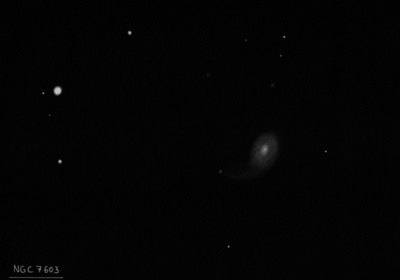
Albert Marth discovered NGC 7603 = m 566, along with NGC 7589, on 23 Oct 1864 and noted "F, vS, stellar." His position is accurate.
There is a long-standing redshift controversy with this pair first mentioned by Arp in ApL, 7, 221, 1971. NGC 7603, the brighter galaxy, has a redshift z = .029 (~390 million ly) while its companion NGC 7603B has a much higher redshift z = .057, placing it about twice the distance (~740 million ly). But there appears to be a luminous bridge connecting the objects that is easily visible on the DSS. Also two quasars with much higher redshifts (z = .391 and z = .243) are embedded exactly on line of sight at the start and end of the bridge.
300/350mm - 13.1" (8/11/85): faint, small, round, sharp concentration, stellar nucleus. Located ~5' W of a mag 9 star.
400/500mm - 17.5" (8/1/87): moderately bright, fairly small, oval ~N-S, sharp concentration, small bright core, stellar nucleus. Forms a pair with NGC 7589 8' WNW. Located 5.1' SW of a mag 9.5 star.
600/800mm - 24" (9/1/16): at 220x; bright, small, round, contains a very small unusually bright core that increases to an extremely bright stellar nucleus (Seyfert galaxy)! Forms a close (line of sight) pair with NGC 7603B 1.0' SE. The companion appeared extremely to very faint, extremely small, only ~6" diameter, required averted to see (V = 15.9, B = 16.7).
900/1200mm - 48" (10/29/16): at 610x; bright, moderately large, round, sharply concentrated with a very bright core and an intensely bright stellar nucleus! The roundish halo gradually fades out around 1.0' diameter. The beginning of a tidal arm is occasionally visible on the south side, extending a short distance to the southeast, but not reaching NGC 7603B. The apparent companion, resides far in the background at a redshift distance of ~740 million ly. It appeared fairly faint, fairly small, round, 0.3' diameter, very small brighter core, stellar nucleus. A hint of the apparent bridge from NGC 7603 is just visible close west, but was not seen as connected.
48" (10/22/11): at 375x, this Seyfert galaxy is unusually sharply concentrated and displayed an extremely bright stellar nucleus surrounded by an intensely bright, 20" core with a much fainter outer halo extending 1.3'x1.0'. Forms a close pair with NGC 7603B = PGC 71041 just 1' SE. At 610x, the small companion is just outside the halo of NGC 7603 and appeared fairly faint, fairly small, round, 20" diameter.
Notes by Steve Gottlieb